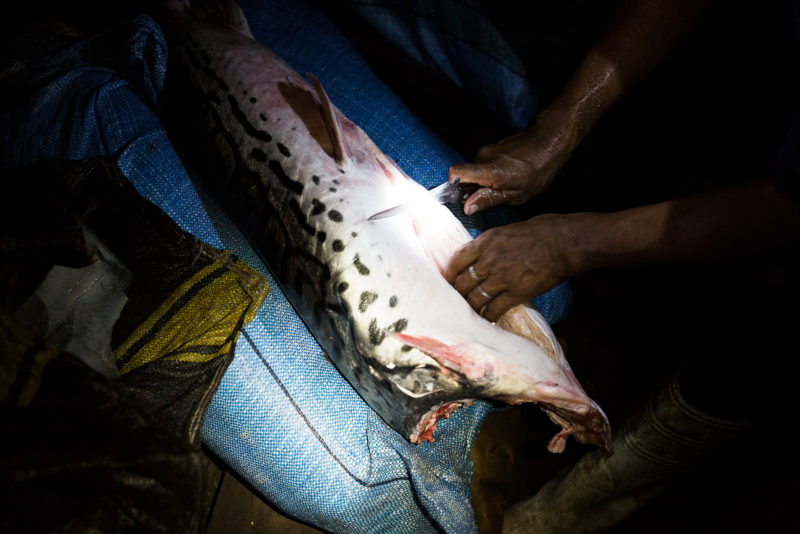It was sunset along the Lago Mentiroso, or Lying Lake, a narrow bow of water north of the Madre de Dios River, deep in Bolivia’s Amazon Basin. Blue macaws shrieked high over the dark, still water. Fireflies gathered in the water hyacinth that fringed the lake’s edge. Every so often, a deep porcine grunt and a heavy splash echoed out from under the tall, dark naves of half-submerged roots. “Una vaquita,” whispered Jairo Canamari, one of four fishermen from the nearby village of Trinidadcito who’d brought me out to the lake that day—a little cow. It’s one of several names used for the giant, invasive fish that, in the last forty years, has become both a plague and a blessing in this remote corner of Bolivia.
Twenty-six and slight with close-cropped hair, Canamari stood at the helm of our ten-foot canoe, parting the reeds and canes as his older brother Rafael, who sat silently at the back of the boat, rowed us to shore. Gabriel and Ahismed Justiniano Montaño, also brothers, took the middle of the boat, Ahismed with paddle in hand, Gabriel rolling sticky tobacco into graph paper. The hull was already filled with the still bodies of red, yellow, and silver piranhas caught earlier that afternoon for the next morning’s breakfast. At any hint of the big fish, Ahismed’s attention darted like a cat’s toward the origin of the sound. Gabriel blew fragrant smoke through his nostrils: “It keeps the caimans and snakes away,” he explained. He was whispering too. That’s what you do when there are paiche around.

Growing up to eight feet long and five hundred pounds, the paiche is the largest scaled fish in the Amazon and one of the largest freshwater fish on earth. Its torpedo-shaped body is covered in glossy black scales, while its head is plated in armor the color of moss. At night, its eyes shine Day-Glo green, like some kind of Miocene zombie.
When the first paiche turned up in the Lago Mentiroso, sometime in the early 1980s, no one knew what it was or where it had come from. Rumors spread quickly, often faster than the fish itself. In the town of San Buenaventura, just south of the paiche’s current range, stories circulated of it attacking humans. In other villages, some won’t eat the paiche because they believe its brain is infested with worms. In Guayaramerín, on the Brazilian border, a fisherman told me, “When the paiche gets mad...
You have reached your article limit
Sign up for a digital subscription and continue reading all new issues, plus our entire archives, for just $1.50/month.
Already a subscriber? Sign in




